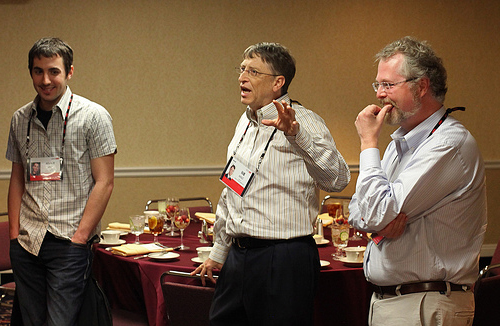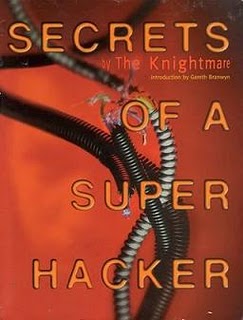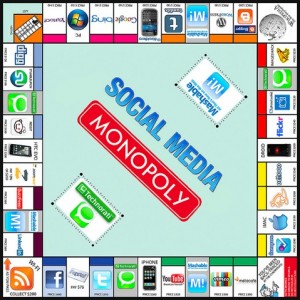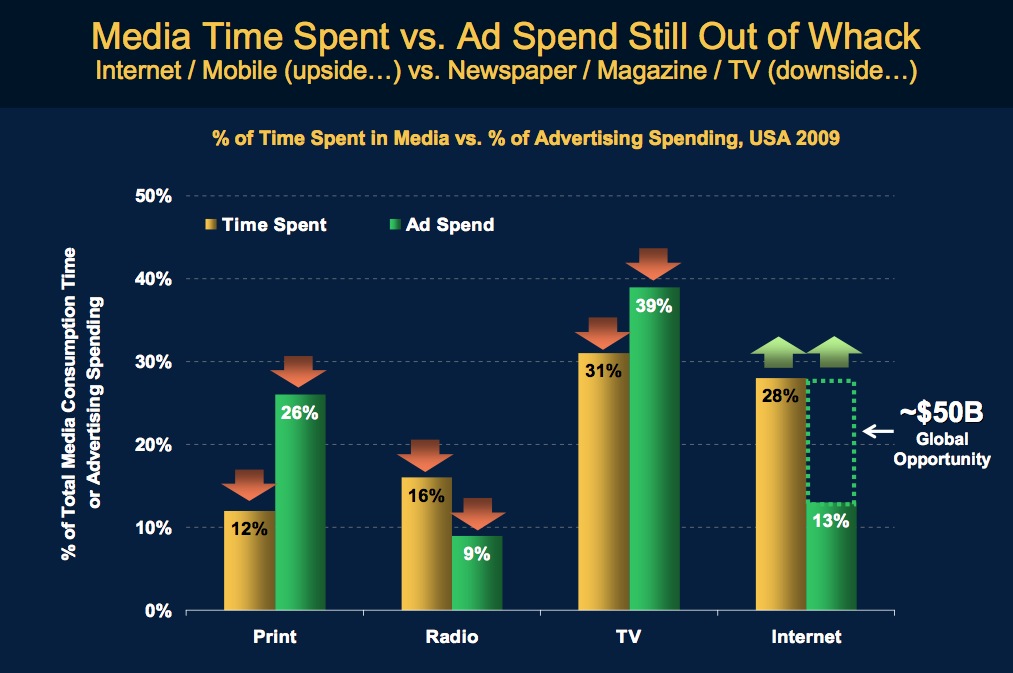Google, Yahoo Struggle with Technology Innovation
March 30, 2011
 Google is taking a slice from Apple’s strategy, bringing back company co-founder Larry Page to ignite innovation at Google, where the stock has flatlined for the past year. Page is scheduled to take over next week as CEO from Eric Schmidt, who is reportedly under consideration for the Secretary of Commerce position in U.S. President Barack Obama’s cabinet.
Google is taking a slice from Apple’s strategy, bringing back company co-founder Larry Page to ignite innovation at Google, where the stock has flatlined for the past year. Page is scheduled to take over next week as CEO from Eric Schmidt, who is reportedly under consideration for the Secretary of Commerce position in U.S. President Barack Obama’s cabinet.
It’s often difficult for mature companies to innovate the way startups do. For one thing, they lack the financial compulsion that drives entrepreneurs to market or die. Look at how News Corp. has shouldered losses at MySpace while Facebook restlessly innovates, or what happened to AOL after the merger with Time Warner, or what might happen to The Huffington Post now that it has been acquired by AOL. Google can afford to simply hold onto a company such as YouTube without the pace of self-improvement often seen in startups.
Amir Efrati, who covers the Internet for The Wall Street Journal, has been stirring things up in Silicon Valley this past week with fascinating reports on attempts by Google and Yahoo to stay innovative. In an article last Saturday, Efrati used unnamed sources to speculate that Larry Page is being called back to “speed up what [Page] says has been sluggish decision-making at Google’s top levels.”
One of Page’s new edicts, according to The Wall Street Journal, is face-to-face bullpen sessions:
… [E]very afternoon, [Page] and the company’s executive officers sit and work on small couches outside a boardroom in Building 43 at Google’s headquarters.
That might have worked when Page left the company in 2001, with 200 employees. Whether it will work 10 years later, with over 100 times as many people on the payroll, remains to be seen.
The difficulty of fostering innovation in mature companies is one of the main drivers behind the Minitrends project at Technology Futures, Inc., the Austin, Texas, technology forecasting firm and publisher of the book, MINITRENDS, and this blog. The authors devote a significant portion of the book to fostering innovation in large corporations:
Fewer than 30 percent of the companies listed on the Fortune 100 twenty-five years ago are still on the list today. Often the primary reason for the demise of such companies has been a failure to recognize and react to changing trends.
One of the ways that companies innovate is through acquisition rather than invention. Efrati generated a second round of buzz this week when he quoted Yahoo’s director of development, Steven Mitzenmacher, on The Wall Street Journal‘s Digits blog as saying Google’s investment in YouTube was “crazy.” It’s an odd comment, given YouTube’s burgeoning revenues and the fact that Yahoo is embarking on a buying binge to remain relevant.
Savvy institutional investing reporter, Riley McDermid, follows the fallout from Page’s return to Google in an insightful article at VentureBeat. Always one step ahead of the competition, McDermid managed to write about The Wall Street Journal‘s article a day before the article appeared. It’s hard to keep up with futurists!
So where do large corporations find the stimulation they need to stay at the forefront of technology trends? Among the resources mentioned in MINITRENDS are innovation competitions and working papers. Among the best examples of where to find both is the National Collegiate Inventors and Innovators Alliance (NCIIA), which held its version of “March Madness” — an innovation competition — in Washington, D.C., last Saturday.
The NCIIA competition is sponsored by companies that are working to stay competitive and rewarding innovation in education. The NCIIA has already published all the conference papers online, for free; they contain a treasure-trove of ideas for mature companies looking for a little stimulation or entrepreneurs looking for adventure.
If you prefer to watch rather than read, we recommend you screen the videos submitted to the NCIIA’s “Open Mind” Awards and nicely catalogued by David Orsman at Inventors Digest. It’s by doing research like this that you are likely to find the Larry Pages and Steve Jobs of tomorrow, who will set the technology trends that others follow.
STEVE O’KEEFE
News Editor, Minitrends Blog
Source: “Obama Nears Appointment Of Eric Schmidt As Commerce Secretary,” BusinessInsider, March 18, 2011
Source: “At Google, Page Aims to Clear Red Tape,” The Wall Street Journal,” March 26, 2011
Source: “Larry Page already cracking the whip at Google, a week before he takes the reins,” VentureBeat, March 25, 2011
Source: “Yahoo Executive Talks Acquisitions, Slams YouTube Buy,” The Wall Street Journal‘s Digits Blog, March 28, 2011
Source: “The Open Minds Awards: Taking Innovation off Campus & into Commercialization,” Inventors Digest, Feb. 18, 2011
Photo courtesy of Jeff Keyzer (mightyohm), used under its Creative Commons license.
Business Model Trends – The Good, The Bad, and The Ugly
March 22, 2011

Kevin Rose of Digg, Bill Gates of Microsoft, and Nathan Myhrvold of Intellectual Ventures at the TED Conference (Photo courtesy of Steve Jurvetson).
Two days before an earthquake measuring 9.0 on the Richter scale struck Japan, resulting in a devastating tsunami and near meltdown at the Fukushima nuclear power plant, we wrote on this blog about “the growing interest in nuclear power” as an alternative to coal fired power plants.
Oops!
While nuclear power-generating facilities have been greatly improved since the Fukushima reactors were built — and the prospects for nuclear energy in the future are still bright — the timing is bad. The prospects for nuclear energy in the short term have dimmed as the costs associated with using that technology are being recalculated.
That wasn’t the only thing wrong with my blog post. A reader called my attention to the case against venture capitalist Nathan Myhrvold’s company, Intellectual Ventures. Myhrvold is the former chief technology officer of Microsoft whose new company invests in technology rather than investing in companies. Intellectual Ventures buys the rights to patents it likes, then markets those patents to other firms. Or does it?
According to Mike Masnick, the prolific and outspoken editor of TechDirt, Myhrvold’s venture is not based on marketing patents but on “shaking down” companies by suing anyone using its patents without permission. Masnick accuses Intellectual Ventures of disguising its true business model by using shell companies to file the lawsuits:
[Intellectual Ventures] had decided to protect its brand name by getting other companies or creating those companies itself, giving the patent to those other companies that no one had ever heard of, and having them sue.
Ouch!
While we did praise Myhrvold’s business plan on this blog, his method for picking technologies to invest in was our focus, not his manner of collecting on those investments. However, without beating up on ourselves too much, we should point out that another company with a strikingly similar business plan has been the recipient of tremendous admiration in the media these past few weeks.
I’m speaking of ARM, the technology company behind the low-heat computer chips used in Apple’s iPhone and iPad, along with many other smartphones and tablets. The company is not bashful about its creative structure:
ARM has an innovative business model. Instead of bearing the costs associated with manufacturing, we license our technology to a network of partners, mainly leading semiconductor manufacturers and OEMs. These partners utilise our designs to create smart, low energy chips suitable for modern electronic devices.
This structure — licensing technology rather than manufacturing it — has led to a gross margin for ARM of 94%. With revenue of $631 million in 2010, ARM had a profit of $593 million. You have to envy that ratio, no matter what business you’re in.
ARM’s business model is similar to Intellectual Venture’s stated mission, yet while Myhrvold is the recipient of scorn from TechDirt and others, ARM is getting nothing but love these days. Renown technology strategist, Michael J. Fern, gushes over ARM’s business model, saying it confers “three significant advantages over Intel.”
The Wall Street Journal joined the praise parade, with University of Chicago-trained economist and new “Heard on the Street” columnist, Rolfe Winkler, noting “ARM… doesn’t have to deal with manufacturing costs or the risks of holding inventory. It’s a deeply profitable business.”
The best take on ARM’s business model, from a Minitrends perspective, comes from the recent article by Om Malik at the influential blog, GigaOM. In a post critical of Twitter’s business model, the highly-respected tech journalist compares and contrasts the business models of half-a-dozen tech companies, including Xerox, Apple, Google, and ARM. Relying heavily on the work of business guru Alex Osterwalder, Malik concludes that “the business model innovation is what turns great products into fearsome companies.”
Sometimes, the most beautiful business models can turn ugly down the road. I was teaching a workshop once when a perplexed attendee kept interrupting with questions. “How do you generate sales,” he asked. “I don’t have sales,” I answered, “I only have expenses. All I have to do is cover my expenses.”
I was describing the workings of a technology startup that made videos of businesses without charging those businesses. Costs were recouped by finding sponsors to cover the expenses. The fellow in the back of the room couldn’t understand the business model and, as it turns out, neither could investors or sponsors. An early online video play, the company died in 2008 for lack of revenue.
The clever idea of yesterday can seem brilliant or stupid a few years — or even a few days — later. That’s why, for your own Minitrends Adventure, we recommend spending as much time thinking about the business model as you do about the services or goods being sold.
STEVE O’KEEFE
News Editor, Minitrends Blog
Source: “Nathan Myhrvold on Uncovering and Investing in Technology Trends,” Mintrends Blog, March 9, 2011
Source: “Nathan Myhrvold’s Intellectual Ventures Using Over 1,000 Shell Companies To Hide Patent Shakedown,” TechDirt, Feb. 17, 2010
Source: “ARM Disrupting Intel with its Business Model?,” FernStrategy, March 10, 2011
Source: “Getting an ARM Up on Intel,” The Wall Street Journal, March 17, 2011
Source: “What Is Twitter’s Problem? No, It’s Not the Product,” GigaOM, March 8, 2011
Photo courtesy of Steve Jurvetson, used under its Creative Commons license.
Denial of Service Attacks Spread in Web’s First InfoWar
December 9, 2010
 Nearly 20 years ago, when promoting a book called Secrets of a Super Hacker by an author named “The Knightmare,” I got a wake-up call about how vulnerable the Internet was. This week, many companies have learned how vulnerable they are after being shut down by hackers related to the WikiLeaks drama.
Nearly 20 years ago, when promoting a book called Secrets of a Super Hacker by an author named “The Knightmare,” I got a wake-up call about how vulnerable the Internet was. This week, many companies have learned how vulnerable they are after being shut down by hackers related to the WikiLeaks drama.
Yesterday, MasterCard’s website was shut down for hours by a group of hackers angry that the credit card company had ceased processing payments to WikiLeaks. Andy Greenberg has been following this story minute-by-minute on The Firewall, his computer security column for Forbes:
MasterCard, which cut off services to WikiLeaks Tuesday, became the latest victim of a loose group of hackers known as Operation: Payback Wednesday morning, when its website went down under a flood of junk traffic sent by the group’s volunteer army… PayPal has already come under two cyberattacks after its decision to cut off its services to WikiLeaks last Friday night… And now PayPal may be back on its target list, followed by Twitter.
The technique being used in these attacks is a “Distributed Denial of Service” attack, or DDoS. The idea is to temporarily take control of thousands of computers on the Internet and direct them to a single Web address, causing the site to falter and eventually shut down. This technique was used by a hacker named “Jester” to shut down WikiLeaks in November. It’s the same technique being used by “Operation: Payback” and a group of hackers named “Anonymous” (a.k.a. “4Chan”) to retaliate against companies such as Amazon, PayPal, Visa, and others who have severed support services to WikiLeaks.
If you’re wondering what it’s like enduring a DDoS attack, Bill Brenner, the information security expert for CSO Magazine, provides a minute-by-minute account of the July 4, 2009, cyberattack that took out the Federal Trade Commission’s website, along with the Department of Transportation, and many private companies:
In that onslaught, a botnet of some 180,000 hijacked computers hammered U.S. government websites and caused headaches for businesses here and in South Korea.
This is the infamous attack that caused Google to publicly blame Chinese hackers, leading Google to eventually move its servers out of mainland China. By way of comparison, the attack on WikiLeaks last week was estimated at nine times larger than the infamous Fourth of July attack. Ironically, one of the 250,000 diplomatic cables recently released by WikiLeaks implicates the Chinese government in the Fourth of July attacks.
In a tweet on December 3 related to the WikiLeaks hackathon, Electronic Frontier Foundation co-founder John Perry Barlow uttered the syllables many a CIO has feared: “The first serious infowar is now engaged.” Barlow was one of the experts I approached in 1993 to review the book, Secrets of a Super Hacker.
The promotion for that book included a contest offering a prize to the first person who could hack my email account and send an email from my own account claiming the prize. When I first proposed the contest, the publisher’s Internet Service Provider (ISP) immediately notified all their subscribers, resulting in such an outcry that we decided to move the contest. Next, I approached The WELL, the cybercommunity in San Francisco where Barlow and many now famous members of the digerati hung out.
The WELL wanted no part of our contest, either, and threatened to suspend our account if we tried to run it there. I thought they would be pleased to have this benign test of their security systems. Instead, The WELL and several other ISPs I approached wanted no part of our hacking contest. Why?
After discussing the situation with several ISP administrators, I realized that security was not a priority for many of them. Most of them were using whatever weak protection came standard with the software they bought. They did not want their systems tested. If they had any extra money, they spent it on marketing: sprucing up the front door, not patching up the back door.
Our little contest served as a wake-up call for several service providers at the dawn of the Internet era. The infowar between WikiLeaks’ opponents and defenders should act as a loud wake-up call to online organizations everywhere to check their defenses. Cyber warfare has come of age, and the stakes now are higher than anyone imagined.
STEVE O’KEEFE
News Editor, Minitrends Blog
Source: “MasterCard Taken Down By WikiLeaks Supporters, Twitter Next?,” Forbes, 12/08/10
Source: “What it’s like to get hit with a DDoS attack,” CSO Magazine, 12/08/10
Source: JPBarlow on Twitter
Image: Book cover of Secrets of a Super Hacker is used under Fair Use: Reporting.
What’s On TV? Amazon, Netflix, Apple, Google…
December 7, 2010
 Last week, we wrote about the growing trend of consumers “cutting the cord” and switching from watching broadcast or cable television to watching streaming TV through the Internet from the likes of Netflix and Hulu. This week, things are getting ugly. Broadcast and cable companies are fighting back while Amazon and other competitors prepare to enter the couch-potato war.
Last week, we wrote about the growing trend of consumers “cutting the cord” and switching from watching broadcast or cable television to watching streaming TV through the Internet from the likes of Netflix and Hulu. This week, things are getting ugly. Broadcast and cable companies are fighting back while Amazon and other competitors prepare to enter the couch-potato war.
Let’s start with what some are calling “The Death of Net Neutrality.” At the end of November, Comcast looked at the amount of Netflix data it was sending to Comcast subscribers and decided it wasn’t being paid enough to handle it. Comcast insisted on a surcharge from Level 3, a company that processes Netflix streams.
Level 3 cried “foul,” and squealed about the surcharge to all who would listen, including the feds, who are currently evaluating Comcast’s proposed takeover of NBC Universal. Comcast then issued a “wait just one minute” statement telling its side of the story. Both Level 3’s punch and Comcast’s counterpunch are covered crisply by Mark Huffman at ConsumerAffairs.com. Within days, Level 3 issued a “clarification” of its position. An apology? No! A rebuttal of Comcast and a repeat that this is a stickup on the information superhighway.
For the lowdown on this shakedown, you couldn’t ask for a better guide than Scott Woolly, who covered technology for Forbes before becoming a contributing editor at Fortune. Covering the fracas for M.I.T. Technology Review, Woolly says:
The history of fights between big networks indicates that one of two things will soon happen in the Comcast-Level 3 fight. Either the two companies will privately settle their differences, or they will start an all-out war that balkanizes the Internet — what is known in the trade as ‘depeering.’
But the Comcast surcharge means little to Netflix compared to the bomb dropped in Monday’s Wall Street Journal, where reporters Nick Wingfield and Sam Schechner came out of nowhere with this scoop:
Amazon.com Inc. is developing a Netflix-like subscription service that would offer TV shows and movies, according to people familiar with the matter.
This comes just two weeks after Netflix moved onto Amazon’s cloud, which is a little roomier now that Amazon has booted WikiLeaks off the cloud. And if that isn’t bad enough, over the weekend, Google purchased Netflix supplier Widevine, a digital video management company. Widevine optimizes the streaming of Netflix videos over the Internet. The acquisition will help Google TV in its battle against Apple TV, Netflix, and, coming soon, Amazon TV.
Just when you thought it was safe to cut the cord, you look around and realize everyone has a knife in this fight. Right now, most of them are pointed at Netflix.
STEVE O’KEEFE
News Editor, Minitrends Blog
Source: “Netflix Supplier Complains About Comcast Fees,” ConsumerAffairs.com, 11/30/10
Source: “Level 3 ‘Clarifies’ Position On Comcast Fees,” ConsumerAffairs.com, 12/06/10
Source: “Peer Pressures Could Strain the Web,” M.I.T. Technology Review, 12/06/10
Source: “No Longer Tiny, Netflix Gets Respect — and Creates Fear,” The Wall Street Journal, 12/06/10
Source: “Google buys Widevine to beef up DRM offering,” Fortune, 12/06/10
Photo by Mark Robinson (me’nthedogs), used under its Creative Commons license.
Technology Trends for Entrepreneurs
December 6, 2010

Android-operated microwave oven, from Touch Revolution video.
Entrepreneurs don’t only create new technology trends, they also use them to take care of businesses. One example is the trend away from using in-house journalists to using freelance journalists to using custom content farms.
An example of an entrepreneur who has successfully mined the Minitrend of content farming is Jonathan Blum. Blum has shifted from a career in broadcast journalism, where he worked for MTV and covered the O.J. Simpson trial for ABC News, among other accomplishments, to a career in custom journalism through his award-winning startup, Blumsday.
Blumsday provides custom content for high-end clients, including CNN and TheStreet. His articles are regularly featured in Entrepreneur magazine. His work earned a Best in Business Award from the Society of American Business Editors and Writers.
One of Blum’s recent creations for Business Insider is a list of the top tech trends for entrepreneurs or, as he puts it,
[…] the top 25 tech tips, trends and megatrends: what’s new now, what will be new tomorrow and what you can expect to grapple with even farther down the road.
I would argue that most of these are “minitrends” rather than “megatrends” — that is, trends that show the likelihood of widespread adoption in the next two to five years and are the byproduct of such megatrends as the spread of the Internet, the growth of mobile devices, or the need for alternative energy sources.
The first minitrend I notice is the increasing use of slideshows instead of text to render the forecasts of pundits. Last week, we reviewed the top 10 tech trends of veteran computer journalist Eric Lundquist, who also presented his picks in slideshow format. We also covered Verizon’s top tech trends, which were presented with video — another Minitrend we expect to see more of in the coming years.
Many of the trends on Blum’s list will already be familiar to readers of this blog. Some of the less typical ones include:
- Touch Kiosks — Blum suggests that using inexpensive touchscreens from companies such as HP and Acer can save a bundle in self-serve customer service.
- Server Simplicity — New products combine “phone servers, e-mail servers, routers, document servers and firewalls into a single low-cost device.”
- Smart Boards for Smarter Presentations — BoxLight and Epson make portable smart boards that take presentations way past the PowerPoint.
- Apps for Your Apps — New apps that run on your household appliances, such as washers and dryers, TVs and microwave ovens. No fooling. Check out the Engadget review.
- Automatic Decision-Making — As computers get smarter, they can do more of our work for us. Entrepreneurs look forward to the day when they can ask the computer to find the 20 best venture capital prospects for a business, then return after a coffee break to find a quality list waiting. Blum points to Google’s Aardvark as an early example of an intelligent assistant.
- Virtual Assistant — Using a bot to represent you at meetings, recording what happens and answering questions by accessing all your computer files, may be more than five years away, but it’s still fun to ponder.
Blum has lots of other tips in his presentation — especially for the eco-conscious entrepreneur interested in energy-saving technologies. I recommend you take his presentation for a ride. It’s a quick trip that really delivers do-it-now ideas for entrepreneurs on the go.
STEVE O’KEEFE
News Editor, Minitrends Blog
Source: “The Future-Proof Entrepreneur: 25 New Tech Trends You Need To Know About,” Business Insider, 11/14/10
Source: Blumsday, undated
Image: Screen capture from Touch Revolution video presentation, used under Fair Use: Reporting.
FTC Advocates Do-Not-Track; Advertisers Upset
December 3, 2010

Screen capture from the Interactive Advertising Bureau's "AboutAds.info" opt-out page. To install the IAB's opt-out software, users must expose their browser to significant privacy risks by enabling cookies.
On December 1, the U.S. Federal Trade Commission presented a preliminary report (PDF) outlining a “framework for privacy” that endorses a “Do-Not-Track” option for Web browsers similar to the agency’s popular “Do-Not-Call” service for telephones.
Unlike the Do-Not-Call program, which creates one central place where individuals can easily add their phone numbers to the list, with reprisals for companies that violate their preferences, the Do-Not-Track mechanism (“DNT”) will be built into the Web-browsing software and other applications used to access the Internet from computers, tablets, and smartphones. Each piece of software or app would have to include a DNT feature. Currently, there are no proposed guidelines for consistently implementing that feature, nor any real authority to enforce it.
Forbes‘ new privacy blogger, Kashmir Hill, says, “At the end of the day, this report isn’t going to change anything.” Kevin Fogarty, the highly opinionated blogger for ITworld‘s “CoreIT” blog, is blunt in his assessment, calling the FTC report:
[…] a set of recommendations with roughly the same clarity, credibility and impact of a strongly worded letter from the U.N. to this year’s evil dictator asking him to please not kill and eat so many villagers.
At The Huffington Post, consumer rights activist Jamie Court threatens a privacy initiative in California: “If Congress doesn’t act, we will go to the ballot.”
While Internet giants, including Google and Microsoft, have learned to tame their public pronouncements and pay lip service to the FTC’s recommendations, they let the trade groups they fund do the barking for them. Mike Zaneis, senior vice president and general counsel of the Interactive Advertising Bureau (IAB), is quoted by The New York Times media reporters Edward Wyatt and Tanzina Vega as saying that the DNT mechanism will cause “significant economic harm” if it has “a high participation rate similar to that of do not call.”
The IAB is recommending voluntary measures where sites place prominent “opt-out” buttons that disable tracking, rather than a central registry or browser build-ins. The organization touts its AboutAds.info site, where you can opt out of being tracked by a very small group of sites that participate.
John and Carrie Vanston devote a major section of their new book, MINITRENDS, to business opportunities arising from increasing interest in privacy. They predict that the U.S. will strengthen its privacy laws, opening up profitable new business lines for entrepreneurs:
The federal government of the United States has adopted only limited formal legislation to protect privacy compared to Canada and most European countries.
Among the businesses that will profit from strengthening privacy laws are software developers, training firms, and the new field of online reputation management companies.
Certainly, someone needs to come up with a solution better than the IAB’s “opt-out” site. When this reporter visited the site to test the opt-out features, I was advised I would have to enable cookies in order to install the software (see screen capture, above). While enabling cookies would protect me from being tracked by few dozen sites participating in the IAB’s program, it would open me to tracking by the millions of sites that not only don’t participate, but sometimes use methods that are much more intrusive than those of IAB’s supporters — methods which remain, unfortunately, virtually unregulated.
STEVE O’KEEFE
News Editor, Minitrends Blog
Source: “Protecting Consumer Privacy in an Era of Rapid Change” (PDF), Federal Trade Commission, 12/10
Source: “Brief Takeaways — and a Pretty Diagram — from the FTC’s Online Privacy Recommendations,” Forbes, 12/01/10
Source: “FTC becomes aware there is an Internet,” ITworld CoreIT Blog, 11/17/10
Source: “Will We Get a ‘Do Not Track Me’ List for Our Personal Information Online?” The Huffington Post, 12/01/10
Source: “F.T.C. Backs Plan to Honor Privacy of Online Users,” The New York Times, 12/01/10
Source: MINITRENDS How Innovators & Entrepreneurs Discover & Profit From Business & Technology Trends, p. 97.
Image from AboutAds.info, the Interactive Advertising Bureau’s “opt-out” site, screen capture recorded 12/02/10. Used under Fair Use: Commentary.
Is Google a Monopoly? EC Launches Investigation
December 2, 2010
 We monitor technology trends on this blog. One of the biggest tech trends of late is accusing Google of having a monopoly, or monopolies (plural), which begs the question of what, exactly, Google has a monopoly over? Most of the accusations center around search.
We monitor technology trends on this blog. One of the biggest tech trends of late is accusing Google of having a monopoly, or monopolies (plural), which begs the question of what, exactly, Google has a monopoly over? Most of the accusations center around search.
“Google ‘owns’ search,” says Columbia Law Professor, Tim Wu, in a November 13 piece for The Wall Street Journal‘s WSJ “Review” section. Wu’s new book, The Master Switch, is sounding the “Google as monopoly” bell which rang loudly before the U.S. Presidential elections in 2008 but has quieted down since.
Wu’s definition of “ownership” is quite a bit looser than a pure monopoly. Google “owns” less than two-thirds of the search market, according to ComScore. In June of this year, Google held 62.6% of search queries; Yahoo held 18.9%; and Microsoft’s Bing has grown to an impressive 12.7%. Having a dominant position in a field with few barriers to entry is not a monopoly. Just ask MySpace.
Two days ago, however, the accusations that Google has a monopoly moved from the rhetoric to real threat as the European Commission opened an investigation into whether Google has abused its position as the dominant search engine by intentionally skewing search results to benefit entities it owns. From the EC’s press release announcing inquiry launch:
The Commission will investigate whether Google has abused a dominant market position in online search by allegedly lowering the ranking of unpaid search results of competing services which are specialised in providing users with specific online content such as price comparisons (so-called vertical search services) and by according preferential placement to the results of its own vertical search services in order to shut out competing services. The Commission will also look into allegations that Google lowered the ‘Quality Score’ for sponsored links of competing vertical search services. The Quality Score is one of the factors that determine the price paid to Google by advertisers.
The argument here is not that Google is a monopoly because of its size. Rather, that Google has used illegal means to penalize competitors, which is what eventually gets so-called monopolies in trouble. I have long suspected that Google Blog Search favors blogs on the Google-owned Blogger/BlogSpot platform over rival WordPress. The EC review is based on favoring Google’s price comparison results over rival Foundem.
Two Google vice presidents have posted a response to the EC’s announcement on the Google Public Policy Blog, but they do not dispute the EC’s claim of favoritism. It was Microsoft’s exclusionary sales contracts that required PC makers to install its operating system and not competing software that got the software maker into antitrust trouble, not its market share.
As long as consumers have access to alternatives, does Google really have a monopoly on search? Does Facebook have a monopoly on social networking? The same could have been said of MySpace three years ago. MySpace has suffered hundreds of millions of dollars in losses for owner News Corp. Facebook could fade just as fast and, believe it or not, so could Google. In a previous post on this blog, we cited Morgan Stanley’s Mary Meeker as noting that seven of the top 15 Internet companies by market capitalization in 2004 are not in the top 15 today.
The primary reason for the demise of [Fortune 100] companies has been a failure to recognize and react to changing trends.
Those words come from the new book, MINITRENDS, by futurist John Vanston with Carrie Vanston. One of the main reasons the Vanstons wrote this book was to give large companies a formula for staying innovative. It’s easy for entrepreneurs to pioneer new ideas, and often much harder for those ideas to come from within giant organizations. But it can be done, and MINITRENDS provides a process these giants can use to identify and develop new methods and markets.
It has been Microsoft’s argument against the antitrust regulators that, absent criminal barriers to entry, its businesses are open to competition and subject to decline unless Microsoft continually innovates. Bill Gates, who is no stranger to the issues now facing Google, lashed out at Matt Ridley, author of the new book, The Rational Optimist, in last weekend’s WSJ Review:
Like many other authors who write about innovation, Mr. Ridley suggests that all innovation comes from new companies, with no contribution from established companies. As you might expect, I disagree with this view.
Gates knows that Facebook’s advertising network could upend Google’s fragile hold over the online advertising market, and that Facebook itself could fade as fast as MySpace did in a matter of a few years. For those companies who hope to stay ahead of the game, as Apple and Microsoft have consistently done, MINITRENDS provides a way of nurturing innovation — a process that itself is a significant innovation — in the quest to remain competitive.
STEVE O’KEEFE
News Editor, Minitrends Blog
Source: “In the Grip of the New Monopolists,” The Wall Street Journal, 11/13/10
Source: “Search engine Bing gains market share,” BBC Technology News, 07/14/10
Source: “Antitrust: Commission probes allegations of antitrust violations by Google,” EUROPA Press Releases, 11/30/10
Source: “MySpace losses lead way down for News Corp.,” Los Angeles Times, 08/05/09
Source: MINITRENDS: How Innovators & Entrepreneurs Discover & Profit From Business & Technology Trends, Technology Futures, Inc., p. 13.
Source: “Africa Needs Aid, Not Flawed Theories,” The Wall Street Journal, 11/27/10
Image by cambodia4kidsorg, used under its Creative Commons license.
Trend of the Year: Social Shopping
November 29, 2010
 In case you hadn’t noticed, this Thanksgiving marked the tipping point of a major new technology trend: Social Shopping. When you combine the spread of social networking, the market penetration of mobile phones, the desperation of retailers to capture more business, and consumers’ love of the deal, you wind up with Social Shopping.
In case you hadn’t noticed, this Thanksgiving marked the tipping point of a major new technology trend: Social Shopping. When you combine the spread of social networking, the market penetration of mobile phones, the desperation of retailers to capture more business, and consumers’ love of the deal, you wind up with Social Shopping.
Richard MacManus, the founder and CEO of ReadWriteWeb, which is consistently one of the best blogs covering Internet technology trends, recently kicked off a series looking back on the top tech trends of 2010. He begins the series by looking at Social Shopping.
In 2010, we’ve seen the rise of so-called ‘social shopping’ services. They rely heavily on technologies such as social networking, crowdsourcing and smart phone scanners. Here we present five of the main social shopping developments of 2010.
MacManus doesn’t just pick five companies to profile, but five different types of Social Shopping technologies. Who knew there were so many? Here are his top picks, along with examples of companies that have been using these technologies to attract consumers:
1. Daily Deals: Companies that send one or more “deal of the day” messages to subscribers. Examples: Groupon, LivingSocial.
2. Real-Time Shopping: These deep discounts might last for only a few minutes or hours or until supplies run out. Example: Woot.
3. Location Check-In Services: These services offer rewards to people who check in frequently or on certain days. Examples: Foursquare, Yelp.
4. Facebook Shopping: MacManus credits Facebook with enabling Social Shopping through deals with Amazon.com and other retailers.
5. Barcode Scanning: Phone apps that allow you to take a picture of a barcode or QR code with your phone, then search for reviews, deals, or other information on the Internet. Examples: RedLaser, ScanLife.
Last week, we wrote about how Google CEO Eric Schmidt revealed a new feature for Android phones that will allow you to skip the barcode photo and just wave your phone near an NFC chip to learn about deals on a product.
If those aren’t enough leads for you to explore the new world of Social Shopping, then take a look at Mashable’s list of 18 Sites for Social Shopping — and don’t forget to look in the comments for another 18 or so!
Happy Holidays!
STEVE O’KEEFE
News Editor, Minitrends Blog
Source: “Top Trends of 2010: Social Shopping,” ReadWriteWeb, 11/15/10
Source: “SHOPPING SPREE: 18 Sites for Social Shopping & Deals,” Mashable, 08/08/07
Photo by Jenelle/Thriving Ink, used under its Creative Commons license.
Google’s Schmidt: “Bump to Buy” Coming Soon to Mobile Phones
November 18, 2010

Google CEO Eric Schmidt holding a new "device" that includes a "bump to buy" NFC chip at the Web 2.0 Summit.
Google CEO Eric Schmidt is keen on mobile phones. He says that people don’t realize how powerful these devices are, and claims they are “more powerful” than desktop computers.
Schmidt made these remarks on November 15 at O’Reilly’s Web 2.0 Summit in San Francisco, where he was grilled for almost an hour by Tim O’Reilly and John Battelle. Both O’Reilly and Battelle come from the world of publishing. O’Reilly is founder and CEO of O’Reilly Media, a well-known publisher of computer books and conference organizer. Battelle was a co-founder of Wired magazine and currently runs Federated Media, an online advertising firm. A video of their conversation with Eric Schmidt is available through the Web 2.0 Summit website.
Early in the interview, Schmidt pulls out a prototype “device” which looks very much like a mobile phone. He explains how this new device, which will appear on the market in the coming weeks, will use a “near field communication” (NFC) chip that you can wave or bump against something to get information about a product, person, or place.
With current 3G smartphones, you can take pictures with your phone and use those pictures to search the Web for information about a product or place. On another blog I write for, the SixEstate blog, online journalism expert Rachelle Matherne describes how smartphones can snap pictures of quick response barcodes (“QR codes”) and get additional information about an advertiser’s products.
The hang-up is that using QR codes requires adding an app to your phone, then taking a picture of the barcode with your phone’s camera. Near field communication eliminates all that fuss. You just bump the item with your phone and instantly retrieve all kinds of information. You can bump a book and discover other books by the same author, or deals offered by multiple vendors on the same product.
The bump gets even better when you attach it to a digital wallet. The new smartphones will enable consumers to “bump to buy,” according to O’Reilly. In his coverage of the Web 2.0 Summit, InformationWeek editorial director, Fritz Nelson, says that “bump to buy” will take time to spread:
This requires an ecosystem of merchants, payment providers and payment processors, and while this ecosystem is starting to form, it’s still evolving. Schmidt later told a gathering of reporters that broader acceptance is probably a year away.
Schmidt, who usually wears a severe demeanor, was positively giddy about the potential of the next generation of mobile phones. He says they are more personal, more secure, and more powerful than desktop computers, and that “mobile first” is his mantra, meaning that the phone will be the focus of Google’s strategy in the coming years.
How important are Schmidt’s remarks to driving the industry? Of the 25 videos posted from the Web 2.0 Summit as of this writing, Schmidt’s interview has been viewed over 120,000 times. Compare that to Zynga’s Mark Pincus — and most of the other well-known speakers — whose videos have been watched only a few hundred times, and you can see that Google is still the engine of innovation driving the new economy.
STEVE O’KEEFE
News Editor, Minitrends Blog
Source: “Web 2.0 Summit 2010: A Conversation with Eric Schmidt,” OReillyMedia, 11/15/10
Source: “Google CEO Schmidt Says NFC To Extend Android Acceptance,” InformationWeek, 11/15/10
Source: “QR Codes and the New Journalism,” SixEstate Blog, 11/09/10
Photo: Screen capture from “A Conversation with Eric Schmidt,” courtesy OreillyMedia.
Meeker’s Top Internet Trends: Online Advertising Undervalued
November 17, 2010

Mary Meeker runs the global technology research team as a managing director of investment giant, Morgan Stanley. When Meeker talks, the market listens, and she was saying plenty at the recent Web 2.0 summit in San Francisco.
On Tuesday, November 16, Meeker shared her picks for the top Internet trends, backed up with some of the most cleverly crafted stats I’ve ever seen. Among the revelations: Print publications occupy only 12% of the amount of time consumers spend with media, yet account for 26% of advertising spending. This does not bode well for the future of advertiser-supported print media.
On the other hand, Meeker’s stats show that the Internet takes up 28% of people’s time for media, yet draws only 13% of advertisers’ budgets. She says there’s $50 billion too little being spent in online advertising.
Mashable’s Ben Parr summarized Meeker’s misallocation thusly: Facebook is “the most under-monitized asset in online advertising.” According to Meeker’s stats, social networking is earning a mere 55 cents per thousand impressions (CPM) from advertisers. Compare this to CPM’s of about $2.70 for the majority of websites that accept display advertising. Also grossly undervalued, according to Meeker, are display ads embedded in email, which earn only 89 cents CPM.
Parr was modest enough not to mention that Mashable ranked as one of the Top 10 brands on Twitter, coming in at position number 10 — right behind the National Basketball Association (NBA) and just ahead of Martha Stewart.
Another slide in Meeker’s presentation compared the number of people who “like” brands on Facebook with the number of viewers for popular television programs — and the CPMs associated with those TV shows. Zynga’s Texas Hold’em Poker leads the likes on Facebook with 27.2 million, which is roughly equivalent to the number of American Idol viewers. Whereas display ads on Facebook cost a mere $0.55 per thousand impressions, American Idol charges $30. We profiled Zynga founder Mark Pincus here on the Minitrends blog last month, where he talked about the importance of good eating habits.
Some of the other trends mentioned in the book, MINITRENDS, which also caught Mary Meeker’s eye, include the growth of virtual worlds. Meeker favorably compared the Japanese social networking site, Tencent (637 million active users), with Facebook (620 million annual visitors). The difference? Tencent is a virtual world using avatars. The shocking stat that caught my attention: over $1.4 billion in virtual goods have been sold on Tencent! Those are real yen shelled out for virtual merchandise such as outfits for avatars.
Another shocking stat: Seven of the top 15 Internet companies by market capitalization in 2004 are not in the top 15 today. Punishment is swift for those who do not stay on the edge of innovation. Case in point: Nokia and RIM held 70% of the smartphone market as recently as 2008. Today, that market share has dropped to 52% while Google (Android) and Apple (iPhone) have gone from nothing to gobbling up 42% of the market.
Despite a Morgan Stanley copyright notice, Mary Meeker’s slideshow seems to be everywhere online. You can find it at Mashable and TechCrunch, along with some very cursory commentary.
STEVE O’KEEFE
News Editor, Minitrends Blog
Source: “The Unprecedented Rise of Apple iOS and Other Internet Trends,” Mashable, 11/16/10
Source: “Mary Meeker On Ten Questions Internet Execs Should Ask And Answer,” TechCrunch, 11/16/10
Image from Morgan Stanley, used under Fair Use: Commentary.


